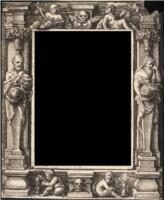The theme of the "Danse macabre" dates back to medieval morality tales of a dialogue between Death and representatives from all classes of society, as well as paintings on the walls of churches and charnel houses. Death comes to the mighty and the lowly alike, leading them off in a long procession [see P265]. Hans Holbein (1497-1543) interpreted the theme in a series of drawings done at Basel about 1525, where forty of them were printed as woodcuts executed by the master engraver Hans Lützelburger the following year. They were printed again as woodcuts in 1538 at Lyons, under a different title, and with additional images being added. The work was immediately popular, and many other editions followed, with woodcuts by a number of different engravers. Hollar evidently worked from a Cologne edition as well as one of the earlier Lyon editions, reinterpreting the Holbein images as a series of thirty etchings rather than woodcuts.
Hollar's prints first appeared in 1651, while he was working in Antwerp, under the title Mortalium nobilitas iconibus ab Holbeino delineatis et a W. Hollar exsculptis expressa. They depict Dance as a prancing skeleton, and have a macabre energy about them. Each of the thirty prints was enclosed in one of three symbolic decorative borders designed by Abraham Diepenbeeck. The three borders depict Democritus and Heraclitus, Minerva and Hercules, and Time and Eternity.
The plates then passed to the publisher N. Pitau of Paris, where they were reprinted about 1680 retaining the Diepenbeeck borders, although the individual prints are not always enclosed in the same border they had in 1651. This constitutes the second state of the plates.
The subject matter, however, was not popular in the later Baroque and Classical periods, and Hollar's plates were not issued again for another hundred years. In 1780 an edition appeared in Basel, with the thirty Dance of Death plates printed but without the Diepenbeeck borders, and the addition of portraits of Holbein and Hollar, explanatory text to accompany the illustrations, and the
Procession of Death plate, which is also found in the
History of St. Paul's Cathedral (
P265). From 1780 onward the Hollar plates reappear also in Paris, Edinburgh, and London printings. The Fisher collection includes a 1790 edition with French text and a 1794 edition with English text in which the plates are still in the second state, without the original borders. In the 1804 English edition included here the plates are of a third state, showing some reworking, and the addition of a sequential number in the lower left corner. Finally the Hollar prints were issued again in a London edition of 1816, with the plates in a fourth state, after having again been reworked. In the example included here the plates are hand-coloured.
Also included in the collection are examples of the Holbein/Hollar Dance of Death plates by two other artists. David Deucher was an etcher who copied Hollar's plates and the Diepenbeeck borders, and issued them in Edinburgh in 1788, with a portrait of himself and an etched title page dated 1786. The plates are mostly printed in reverse, the sequence is not the same as the Hollar editions, and there are some additional plates depicting new subjects. The Fisher collection includes Deucher's plates in a London edition of 1811, and also in a lithographed edition of 1887, by which time the images have become so degraded that very little fine detail remains. Finally the Hollar prints without the borders were re-interpreted as wood engravings by John Bewick, a master of the revived art of wood engraving, with text by T. Tindall Wildridge. This was issued in London in 1887 in a limited edition of 400 copies, of which 60 were hand-coloured.


